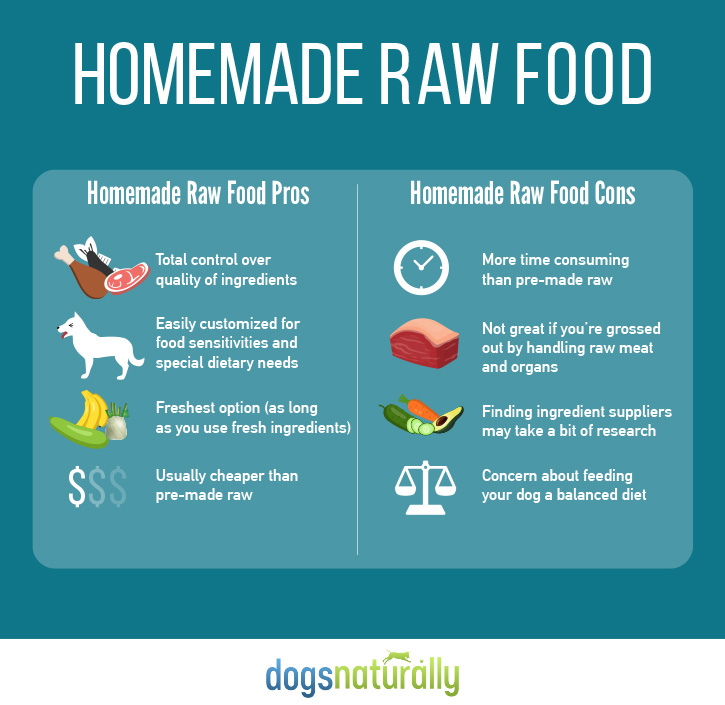If you’ve looked into natural dog food, you’ve heard about all the benefits of raw feeding. Raw food advocates everywhere agree that uncooked, meat-based diets are far more beneficial to dogs than kibble for a number of reasons. Yet even once you’ve joined the raw food club, there’s one remaining debate to consider …
Is it better to make your own raw food or to buy it pre-made from a pet store or online?
Homemade Raw Food
Making your own raw dog food has the advantage of giving you complete control over what your dog eats. This makes homemade a great option for dogs with food sensitivities or health concerns. It’s also more cost effective to make your own than to buy pre-made raw food from a store.
More Than Meat
Creating your own doggy menu involves a lot more than simply serving chicken breast or ground beef every meal. Muscle meat on its own does not contain all of the nutrients that your dog needs for sustained health.
A special meal of steak or chicken breast once in a while is fine (your dog will agree!), but for regular feeding you’ll need to incorporate bones, organ meat, and, if you want, fruits and veggies, plus an essential fatty acid to prevent deficiencies.
Recipe for Success
It’s a good idea to follow a formula … at least until you get the hang of it … to make sure you’re not overlooking anything.
Homeopath Julie Anne Lee recommends the following formula to keep your homemade raw meals simple:
- 50% muscle meat
- 10% organ meat
- 15% uncooked bone
- 20% vegetables
- 5% fruit
- An essential fatty acid – she recommends Atlantic-sourced phytoplankton (a better choice than fish oil, which is very unstable and turns rancid fast) and rotating between coconut oil and hemp oil
- Recreational bones 2 to 3 times per week – These are the “fun” parts. Feet, necks, femurs or knuckles are good choices
You don’t need to feed a perfectly balanced diet at every meal … balance over time is what’s important.
(NOTE: Learn more about raw feeding with your free guide: Click here!)
Variety and Quality
It’s important to change up the type of meat and produce you’re using in order to give your dog the widest range of nutrients and health benefits. Choose high quality, ethically sourced, organic, non-GMO ingredients whenever possible.
Special Needs
If your dog has health issues, you can easily customize this formula to suit your dog’s needs. For example, add dried seaweed to support cell metabolism and thyroid function. Bone broth will help heal a damaged gut and support joints and connective tissue. This formula can be adjusted to meet the needs of geriatric dogs who might need a lower protein level, as well.
Making your own raw dog food also gives you the option to prepare meals fresh as you go along, or you can make large batches and freeze them for future use. Either way gives you and your dog the satisfaction of a healthy homemade meal.

If you’re worried about a balanced diet, or don’t like the idea of handling raw meat and organs on a regular basis … or if the homemade process seems too time consuming, pre-made raw food from the freezer section of your pet store might be a better option. These have the correct ratios of meat, organ, bone and produce already mixed and formed into easy-to-handle patties or nuggets. All you need to do to prepare these meals is thaw and serve!
Food Sensitivities
You’ll have to do some reading if your dog has food sensitivities, but most raw food companies are good about telling you exactly what’s in the bag. A quick check of the ingredient list will let you know if your dog can eat it or not. With their short ingredient lists and a wide variety of proteins (even novel proteins like rabbit, venison, and pheasant), store-bought raw can accommodate most diet restrictions.
Avoid Synthetic Ingredients
While you’re reading ingredients, check to see if the food contains synthetic vitamins and minerals. These will be toward the bottom half of the ingredient list and contain words like proteinate, sulfate, and hydrochloride. Synthetic vitamins are undesirable because they are chemically-based and are not absorbed and used in the body as efficiently as the naturally-occurring vitamins in plant ingredients.

The other concern is that most synthetic vitamins come from China, where food and supplement regulations are lax at best. Even if the bag states that it’s sourced and made in the USA, the food companies don’t have to disclose where their vitamins come from. If synthetic vitamins are listed, it’s a safe bet they’re from China.
Choose a raw food whose nutrition comes from whole food ingredients, not added synthetic supplements.
Related: Vitamins For Dogs: 3 Reasons To Stay Away
High Pressure Pasteurization (HPP)
Another controversial issue of store-bought raw food is that many companies high-pressure pasteurize their products to kill off bacteria from the raw ingredients. That might sound like a good idea, but HPP has some drawbacks. During the HPP process, foods are exposed to massively high pressure, which “cooks” the food. HPP expert George Flick at Virginia Tech University states:
Basically, the effect of high pressure on microorganisms and proteins/enzymes was observed to be similar to that of thermal processing.
Yet it still has that raw price tag!
And because the HPP process treats food already in its packaging, there’s a risk of toxic chemicals like phthalates (endocrine disruptors linked to thyroid and obesity issues) migrating into the food.
If your dog is immune compromised … you may find your veterinarian prefers HPP foods for immune-compromised animals. It’s safer to lightly cook your dog’s food instead of buying HPP food. You’ll lose some nutrients through cooking but you’ll avoid the unknown risks of HPP.
Unpasteurized raw dog food is only as risky as preparing your own meat for dinner. Good hygiene practices can make all the difference, and the benefits your dog gets from truly raw food are considerable.
Related: Avoid This Common Raw Feeding Mistake
What About Cost?
Possibly the biggest issue that deters people from store-bought raw food is the price. Since the food companies are doing all the work of sourcing, grinding, mixing, forming, and packaging the food, it’s going to be more expensive than if you do all that yourself. A 6lb bag goes for around $35 and will last a large dog only a week or so.
Many raw feeders will argue that the cost is worth it, but it’s understandable that the price can make pre-made raw food unaffordable to some.
Transportation Issues
Another unfortunate issue with pre-made raw food is quality control. Even if the manufacturer is stringent in their facility cleanliness and batch testing, once it leaves their facility there’s no way to guarantee that the product won’t thaw and be refrozen on the way to the distribution center and from the distribution center to the store (or your house if you order online).
Thawing and re-freezing doesn’t necessarily render the product useless or dangerous, but it does increase the chance of bacteria growth or ending up with spoiled product. If you find a bag that’s filled with air, or “puffy,” choose a different bag. Puffiness is an indicator that the product was probably thawed at one point and then refrozen.
So Which Do I Choose?
The good news is that either option is decidedly more beneficial to your dog than feeding kibble.
All things considered, there doesn’t seem to be a clear winner in the homemade vs store-bought debate. Both options have their strengths and weaknesses, so your lifestyle and comfort level will probably be the deciding factor.
If you really can’t decide, you can feed a store-bought meal for half of the week to save time and to make sure your dog is getting all her nutrients. The rest of the week feed homemade food to defray the cost. Even if you can’t justify feeding an all-raw diet all the time, your dog will benefit from just a few raw meals per week, whether homemade or store-bought.
The only way to feed raw food wrong is to not feed raw food at all!













